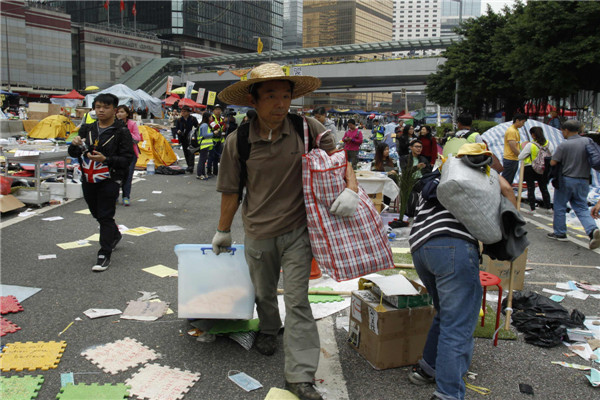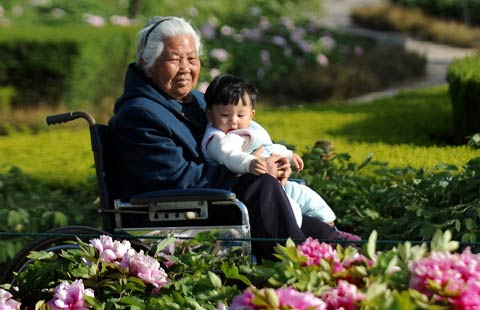Traffic normalized at occupy sites, 209 arrested
Updated: 2014-12-12 09:55
(Agencies)
|
|||||||||||
 |
|
A protester leaves with his belongings before police clear a main road outside the government headquarters in Hong Kong, December 11, 2014. [Photo/Agencies] |
HONG KONG - The traffic in front of the Hong Kong government headquarters has been resumed now after the clearance of the occupy sites by police on Thursday.
Police said 209 people were arrested for unlawful assembly and obstructing police officers. The arrested protesters included Alex Chow, a key member of the Hong Kong Federation of Students, and several Legislative Council members.
As of 22:00 of Thursday, the police completed clearing all barriers in Connaught Road Central, Harcourt Road, Tim Wa Avenue, Tim Mei Avenue and Gloucester Road. Traffic had been resumed in the Connaught Road Central and Harcourt Road, the main thoroughfares in Hong Kong Island, before midnight.
"If anyone attempts to occupy any roads again, the police will take resolute action for law enforcement," according to Cheung Tak-keung, assistant police commissioner.
The police also collected personal ID information of more than 900 protesters who stopped sit-in and left after the police cordoned off the illegal occupy areas. Those protesters may face criminal prosecution in the future.
The police said they would start clearing the last remaining Occupy site at Causeway Bay in Hong Kong Island at an appropriate time.
Thursday's clearance began in the morning at around 10:30 local time ( 2:30 GMT) after bailiffs read out to protesters injunction orders issued by the High Court of Hong Kong.
The bailiffs and their aides successfully cleared tents, fences and other barriers in the occupied areas banned by the court's injunction around noon, which was followed by a comprehensive clearing action in Admiralty taken by the police in the afternoon.
The clearance barely met resistance and many protesters left the Occupy sites peacefully. But still a large crowd of protesters ignored the police's appeal to withdraw from the protest sites and sat on the ground, shouting slogans.
The Occupy protest in Hong Kong started on Sept. 28 and blockaded several main roads and streets in Kowloon and Hong Kong Island, which has resulted in serious traffic disruption, less tourists, temporary closure of schools and banks and a slump in local stock market trading. There had also been a series of clashes between protesters and police.
Simon Wong, president of the Federation of Restaurants and Related Trades, told the media on Wednesday that more than 3 billion HK dollars (about 387 million U.S. dollars) of business loss was recorded in major business centers of Admiralty, Mong Kok and Causeway Bay, the main occupy sites, since the Occupy protest started in September.
The main appeal of the protesters is to oppose a framework set by China's top legislature on the election of Hong Kong's next chief executive by universal suffrage slated for 2017.
Under the Basic Law, the top legislature has decided that chief executive candidates to run the universal suffrage must be nominated by a 1,200-member nomination committee.
Related Stories
'Occupy' has taken a heavy toll on Hong Kong 2014-12-12 07:49
Mainland offers Hong Kong great opportunities 2014-12-11 07:56
An open letter to Hong Kong's younger generation 2014-12-09 07:21
China denies changes in policies toward Hong Kong 2014-12-05 22:03
China rejects Britain's 'moral duty' to Hong Kong 2014-12-03 21:03
Today's Top News
China, Kazakhstan eye further aerospace co-op
Hostages held in Sydney cafe, Islamic flag seen in window
Canada preparing to return property
Tourists who threw water on Thai attendant to face punishment
Overseas centers to help infectious disease research
Executed man not guilty: court
Traffic normalized at occupy sites, 209 arrested
UK sees growth of Chinese companies at record rate
Hot Topics
Lunar probe , China growth forecasts, Emission rules get tougher, China seen through 'colored lens', International board,
Editor's Picks

|

|

|

|

|

|





